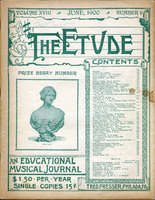A well-known artist tells the following excellent anecdote: One Friday morning he was visited by a very small boy who carried a very large green bag. This green bag proved to contain a fiddle of the Christmas-tree variety; and, when its diminutive owner was called upon to “play something,” the fiddle was hastily drawn from its green receptacle, tucked under the chin, and murderously operated upon without so much as the slightest turning of one peg to facilitate purity of intonation. “But,” hastily interrupted the master, “is your violin in tune?”
“Certainly,” answered the small boy without the slightest hesitation or twinge of conscience.
“But how do you know it is in tune?” persisted the astonished violinist. “You have not tuned the instrument since you entered this room. How, then, do you know it is in tune?”
“Why,” answered the boy, with unmistakable indignation, “my professor tuned it last Saturday morning.”
The small boy with the green bag is not an unfamiliar figure in the studios of our busy teachers. Whatever he may have been taught by his “professor,” it is quite astonishing how little he has been taught concerning the art of tuning the violin. All his ideas associated with this very gentle art seem to be based on certain peculiar principles of physical contortion. His methods undoubtedly have zest and variety, and there can be no question as to his almost endless repertoire of unique contortions. But I will undertake to describe only a few—just a very few—of the many that have come within my personal experience.
The favorite attitude seems to be to grip the fiddle between the knees, twisting and turning the pegs with a sort of desperation until the four strings are approximately in good tune.
A very popular method seems to be to rest the scroll on the convenient piano, scratching hieroglyphics on the latter’s varnish and producing, at the same time, that nerve-splitting shriek which usually accompanies the progress of the fiddle over the piano’s glistening surface.
A third method of tuning the violin embraces the two methods just described, with this additional and characteristic feature, viz.: when the string is pitched only a trifle too high, the peg is entirely ignored and the requisite pitch attained by plucking the string with a vigor that threatens its immediate destruction.
These three methods will amply serve my purpose. I wish to call the student’s attention to the fact that it is quite as easy to learn how to tune the violin with something resembling grace and precision as it is to squirm and wriggle through a process which, in the end, rarely enables the player to accomplish his object with anything like perfection.
The player should invariably hold the violin in the attitude of playing, always tuning with the left hand. Tuning the violin is really quite a knack, and it certainly requires some experience. But the method I have just advised is unquestionably the very simplest and the very best.



